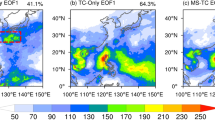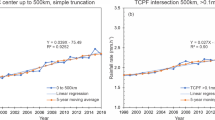Abstract
The Tropical Rainfall Measuring Mission (TRMM) 3B42 precipitation, the National Centers for Environmental Prediction (NCEP) Final analysis and the Regional Specialized Meteorological Center (RSMC) Tokyo best-track data during 2000–2015 are used to compare spatial rainfall distribution associated with Northwest Pacific tropical cyclones (TCs) with different vertical wind shear directions and investigate possible mechanisms. Results show that the maximum TC rainfall are all located in the downshear left quadrant regardless of shear direction, and TCs with easterly shear have greater magnitudes of rainfall than those with westerly shear, consistent with previous studies. Rainfall amount of a TC is related to its relative position and proximity from the western Pacific subtropical high (WPSH) and the intensity of water vapor transport, and low-level jet is favorable for water vapor transport. The maximum of vertically integrated moisture flux convergence (MFC) are located on the downshear side regardless of shear direction, and the contribution of wind convergence to the total MFC is far larger than that of moisture advection. The cyclonic displacement of the maximum rainfall relative to the maximum MFC is possibly due to advection of hydrometeors by low- and middle-level cyclonic circulation of TCs. The relationship between TC rainfall and the WPSH through water vapor transport and vertical wind shear implies that TC rainfall may be highly predictable given the high predictability of the WPSH.









Similar content being viewed by others
References
Black ML, Gamache JF, Marks FD Jr, Samsury CE, Willoughby HE (2002) Eastern Pacific Hurricanes Jimena of 1991 and Olivia of 1994: the effect of vertical shear on structure and intensity. Mon Wea Rev 130:2291–2312. doi:10.1175/1520-0493(2002)130<2291:EPHJOA>2.0.CO;2
Burpee RW, Black ML (1989) Temporal and spatial variations of rainfall near the centers of two tropical cyclones. Mon Wea Rev 117:2204–2218. doi:10.1175/1520-0493(1989)117<2204:TASVOR>2.0.CO;2
Cecil DJ (2007) Satellite-derived rain rates in vertically sheared tropical cyclones. Geophys Res Lett 34:L02811. doi:10.1029/2006GL027942
Chan JCL, Liu KS, Ching SE, Lai EST (2004) Asymmetric distribution of convection associated with tropical cyclones making landfall along the South China coast. Mon Wea Rev 132:2410–2420. doi:10.1175/1520-0493%282004%29132<2410%3AADOCAW>2.0.CO%3B2
Chen SS, Knaff JA, Marks FD (2006) Effects of vertical wind shear and storm motion on tropical cyclone rainfall asymmetries deduced from TRMM. Mon Wea Rev 134:3190–3208. doi:10.1175/MWR3245.1
Chen LS, Li Y, Cheng ZQ (2010) An overview of research and forecasting on rainfall associated with landfalling tropical cyclones. Adv Atmos Sci 27:967–976. doi:10.1007/s00376-010-8171-y
Corbosiero KL, Molinari J (2003) The relationship between storm motion, vertical wind shear, and convective asymmetries in tropical cyclones. J Atmos Sci 60:366–376. doi:10.1175/1520-0469%282003%29060<0366%3ATRBSMV>2.0.CO%3B2
Dare RA, Davidson NE, McBride JL (2012) Tropical cyclone contribution to rainfall over Australia. Mon Wea Rev 140:3606–3619. doi:10.1175/MWR-D-11-00340.1
DeHart JC, Houze RA, Rogers RF (2014) Quadrant distribution of tropical cyclone inner-core kinematics in relation to environmental shear. J Atmos Sci 71:2713–2732. doi:10.1175/JAS-D-13-0298.1
Frank WM, Ritchie EA (1999) Effects of environmental flow upon tropical cyclone structure. Mon Wea Rev 127:2044–2061. doi:10.1175/1520-0493(1999)127<2044:EOEFUT>2.0.CO;2
Frank WM, Ritchie EA (2001) Effects of vertical wind shear on the intensity and structure of numerically simulated hurricanes. Mon Wea Rev 129:2249–2269. doi:10.1175/1520-0493(2001)129<2249%3AEOVWSO>2.0.CO%3B2
Gao S, Chiu LS (2010) Surface latent heat flux and rainfall associated with rapidly intensifying tropical cyclones over the western North Pacific. Int J Remote Sens 31:4699–4710. doi:10.1080/01431161.2010.485149
Gao S, Meng Z, Zhang F, Bosart L (2009) Observational analysis of heavy rainfall mechanisms associated with severe Tropical Storm Bilis (2006) after its landfall. Mon Wea Rev 137:1881–1897. doi:10.1175/2008MWR2669.1
Gao S, Zhai SN, Chiu LS, Xia D (2016) Satellite air-sea enthalpy flux and intensity change of tropical cyclones over the western North Pacific. J Appl Meteor Climatol 55:425–444. doi:10.1175/JAMC-D-15-0171.1
Hence DA, Houze RA (2011) Vertical structure of hurricane eyewalls as seen by the TRMM precipitation radar. J Atmos Sci 68:1637–1652. doi:10.1175/2011JAS3578.1
Huffman GJ, Bolvin DT, Nelkin EJ et al (2007) The TRMM multisatellite precipitation analysis (TMPA): quasi-global, multiyear, combined-sensor precipitation estimates at fine scales. J Hydrometeor 8:38–55. doi:10.1175/JHM560.1
Jiang H, Zipser EJ (2010) Contribution of tropical cyclones to the global precipitation from eight seasons of TRMM data: regional, seasonal, and interannual variations. J Climate 23:1526–1543. doi:10.1175/2009JCLI3303.1
Jones SC (1995) The evolution of vortices in vertical shear: i: Initially barotropic vortices. Quart J Roy Meteor Soc 121:821–851. doi:10.1002/qj.49712152406
Klotz BW, Jiang H (2016) Global composites of surface wind speeds in tropical cyclones based on a 12-year scatterometer database. Geophys Res Lett. doi:10.1002/2016GL071066 (in press)
Lau WKM, Zhou YP, Wu H-T (2008) Have tropical cyclones been feeding more extreme rainfall? J Geophys Res 113:D23113. doi:10.1029/2008JD009963
Lonfat M, Marks FD, Chen SS (2004) Precipitation distribution in tropical cyclones using the tropical rainfall measuring mission (TRMM) Microwave Imager: a global perspective. Mon Wea Rev 132:1645–1660. doi:10.1175/1520-0493(2004)132<1645:PDITCU>2.0.CO;2
Reasor PD, Rogers R, Lorsolo S (2013) Environmental flow impacts on tropical cyclone structure diagnosed from airborne Doppler radar composites. Mon Wea Rev 141:2949–2969. doi:10.1175/MWR-D-12-00334.1
Rogers R, Chen S, Tenerelli J, Willoughby H (2003) A numerical study of the impact of vertical shear on the distribution of rainfall in Hurricane Bonnie (1998). Mon Wea Rev 131:1577–1599. doi:10.1175//2546.1
Rogers RF, Zhang JA, Zawislak J, Jiang H, Alvey GR III, Zipser EJ, Stevenson SN (2016) Observations of the structure and evolution of Hurricane Edouard (2014) during intensity change. Part II: kinematic structure and the distribution of deep convection. Mon Wea Rev 144:3355–3376. doi:10.1175/MWR-D-16-0017.1
Shu SJ, Zhang FQ, Ming J, Wang Y (2014) Environmental influences on the intensity changes of tropical cyclones over the western North Pacific. Atmos Chem Phys 13:6329–6342. doi:10.5194/acp-14-6329-2014
Ueno M (2007) Observational analysis and numerical evaluation of the effects of vertical wind shear on the rainfall asymmetry in the typhoon inner-core region. J Meteor Soc Japan 85:115–136. doi:10.2151/jmsj.85.115
Ueno M (2008) Effects of ambient vertical wind shear on the inner-core asymmetries and vertical tilt of a simulated tropical cyclone. J Meteor Soc Japan 86:531–555. doi:10.2151/jmsj.86.531
Wang B, Xiang B, Lee J (2013) Subtropical high predictability establishes a promising way for monsoon and tropical storm predictions. Proc Natl Acad Sci 110:2718–2722. doi:10.1073/pnas.1214626110
Wingo MT, Cecil DJ (2010) Effects of vertical wind shear on tropical cyclone precipitation. Mon Wea Rev 138:645–662. doi:10.1175/2009MWR2921.1
Wu L, Wang B (2004) Assessing impacts of global warming on tropical cyclone tracks. J Climate 17:1686–1698. doi:10.1175/1520-0442(2004)017<1686:AIOGWO>2.0.CO;2
Wu L, Wang B, Geng S (2005) Growing typhoon influence on East Asia. Geophys Res Lett 32:L18703. doi:10.1029/2005GL022937
Wu D, Zhao K, Jou BJD, Lee WC (2013a) Radar observation of precipitation asymmetries in tropical cyclones making landfall on east China coast. Tro Cyclone Res Rev 2:81–95. doi:10.6057/2013TCRR02.02
Wu W, Chen JL, Huang RH (2013b) Water budgets of tropical cyclones: three case studies. Adv Atmos Sci 30:468–484. doi:10.1007/s00376-012-2050-7
Xu W, Jiang H, Kang X (2014) Rainfall asymmetries of tropical cyclones prior to, during, and after making landfall in South China and Southeast United States. Atmos Res 193:18–26. doi:10.1016/j.atmosres.2013.12.015
Yu J, Tan Z, Wang Y (2010) Effects of vertical wind shear on intensity and rainfall asymmetries of strong Tropical Storm Bilis (2006). Adv Atmos Sci 27:552–561. doi:10.1007/s00376-009-9030-6
Yu Z, Wang Y, Xu H (2015) Observed rainfall asymmetry in tropical cyclones making landfall over China. J Appl Meteor Clim 54:117–136. doi:10.1175/JAMC-D-13-0359.1
Yue C, Gao S, Liu L, Li X (2015) A diagnostic study of the asymmetric distribution of rainfall during the landfall of Typhoon Haitang (2005). Adv Atmos Sci 32:1419–1430. doi:10.1007/s00376-015-4246-0
Zawislak J, Jiang H, Alvey GR III, Zipser EJ, Rogers RF, Zhang JA, Stevenson SN (2016) Observations of the structure and evolution of Hurricane Edouard (2014) during intensity change. Part I: relationship between the thermodynamic structure and precipitation. Mon Wea Rev 144:3333–3354. doi:10.1175/MWR-D-16-0018.1
Zhang JA, Rogers RF, Reasor PD, Uhlhorn EW, Marks FD (2013) Asymmetric hurricane boundary layer structure from dropsonde composites in relation to the environmental vertical wind shear. Mon Wea Rev 141:3968–3984. doi:10.1175/MWR-D-12-00335.1
Zhao HK, Wu LG, Zhou WC (2010) Assessing the influence of the ENSO on tropical cyclone prevailing tracks in the western North Pacific. Adv Atmos Sci 27:1361–1371. doi:10.1007/s00376-010-9161-9
Zheng X, Duan Y, Yu H (2007) Dynamical effects of environmental vertical wind shear on tropical cyclone motion, structure, and intensity. Meteorol Atmos Phys 97:207–220. doi:10.1007/s00703-006-0253-0
Acknowledgements
TRMM 3B42 product is obtained from the National Aeronautics and Space Administration (NASA) Goddard Earth Sciences Data and Information Services Center (GES DISC) of the USA. TC best-track data are provided by RMSC Tokyo - Typhoon Center. NCEP FNL data are provided by the National Center for Atmospheric Research of the USA at http://rda.ucar.edu/datasets/ds083.2/. The authors are grateful to two anonymous reviewers for their constructive comments and helpful suggestions. This work is jointly supported by China National 973 project (2015CB453200), National Natural Science Foundation of China (41505035, 41575078, 41630423), Non-profit Industry Financial Program of MWR of China (201301066, 201401027), Jiangsu Shuangchuang Doctor and Shuangchuang Team Programs, and the Priority Academic Program Development of Jiangsu Higher Education Institutions (PAPD). This paper is Earth System Modelling Center Contribution No. 139.
Author information
Authors and Affiliations
Corresponding author
Additional information
Responsible Editor: M. Kaplan.
Rights and permissions
About this article
Cite this article
Gao, S., Zhai, S., Li, T. et al. On the asymmetric distribution of shear-relative typhoon rainfall. Meteorol Atmos Phys 130, 11–22 (2018). https://doi.org/10.1007/s00703-016-0499-0
Received:
Accepted:
Published:
Issue Date:
DOI: https://doi.org/10.1007/s00703-016-0499-0




